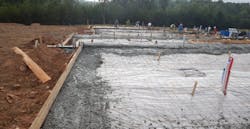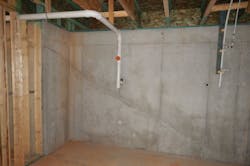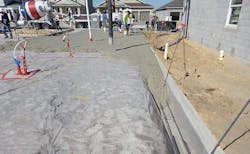Concrete cold joints are common in residential construction. I probably see them on about 75% of the slabs I inspect, as well as in plenty of foundation walls. Cold joints can sometimes wick water into the home, but even without water intrusion issues, their appearance screams “shoddy work” to the homeowner. The problem is easy to avoid if you stop to think about how concrete cures.
What Causes Cold Joints in Concrete?
A cold joint is a sign that too much time elapsed between successive concrete pours. Imagine, for instance, that a concrete crew fills the footing form for a slab-on-grade home (main image, above) or places the first lift of concrete for a foundation wall. If they don’t pour the slab or the second lift soon enough, that first batch of concrete may begin to dry, preventing it from properly intermixing with successive batches.
Cold joints are easy to spot. Some appear as long cracks or discolorations (see photo, below). Others show up as honeycombing or areas of exposed aggregate (see photo, above) caused by a poor mix that prevents the fines (very small aggregate or dust) in the concrete from moving and encapsulating the aggregate as it should.
In a foundation wall, rebar generally prevents cold joints from becoming a structural issue. But with a slab-on-grade home, the lack of vertical steel means a cold joint can become a weak spot.
How to Prevent Cold Joints in Concrete
There are a couple of ways to prevent cold joints. In hot weather, a retarding admixture can slow the drying process. And, of course, properly vibrating the concrete after each pour will help the different layers mix and prevent honeycombs from forming.
However, an admixture will only slow the drying process for a short time. It’s still important to pour the second batch as soon as possible; otherwise it may be too late to stop a cold joint, even if you use a vibrator.
How do you know when it’s too late? Simply, if the concrete surface has started to glaze over that means the pour has begun to set.
RELATED
When pouring slabs in hot climates, such as in Florida, some crews will water down the mix from a 4 or 5 slump to 6 or 7. Although this slows drying and makes the concrete easier to work, that added water can make the cured concrete more porous and reduce its overall strength, potentially allowing for cracks to form. If the slab is to receive a sealed finish—something not uncommon in garages—that porosity will make the finish less predictable. Again, that problem is mostly one of customer perception, but it should not be discounted.
Cold-Joint Solution: Manage the Concrete Pour
The proper solution is obvious: You need to make sure your concrete provider has enough trucks to eliminate waiting between batches. However, the way the crew places the concrete also matters, especially for slab-on-grade foundations.
Most structural engineers specify that the slab and footing be placed at the same time, but crews sometimes ignore that. Instead, they pour the concrete from the first few trucks into the footing forms, then use the concrete from the next few trucks for the slab. It’s easier for crews to work the concrete this way, but by the time they get to the slab, the footing has already started to dry.
The correct sequence is to pour the footing and slab monolithically, moving from one end of the house to the other. It will take a bit more effort to work the concrete into the forms, but cold joints will be far less likely.
Tim Kampert drives quality and performance in home building as a building performance specialist on the PERFORM Builder Solutions team at IBACOS.



